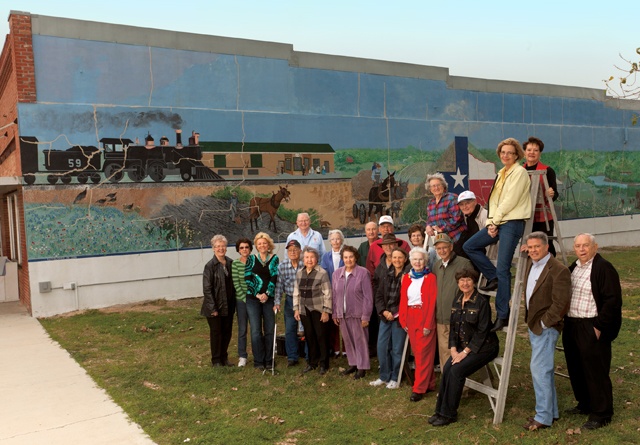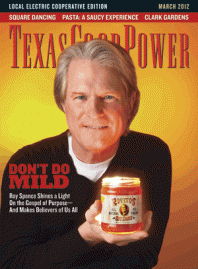On a late Saturday morning in June, cousins Louis Tepera Jr. and Raymond Tepera lounge on the back bumper of a GMC Yukon parked in front of the Buckholts Community Center. Their relatives gather inside for a family reunion.
Buckholts, a town of almost 500 residents on the Blackland Prairie about 20 miles southeast of Temple, huddles up to West Main Street. The sun-bleached and crackled strip is lined with mostly tin and brick buildings, some of which have weathered many triple-digit days since being built around the turn of the 20th century.
Under the open back hatch of the vehicle, the cousins, both in their 70s, discuss farming over 12-ounce cans of Miller Light and Doral Silver cigarettes. The hay is already baled and buyers lined up, says Louis Tepera Jr. The maize is stunted from the drought, observes Raymond Tepera, who holds his hand out at knee height to show just how short the stalks are.
Buckholts has changed from the town their parents knew. Louis Tepera Jr. takes off his straw hat and waves away a honeybee. He remembers when the lot back there—he glances over his left shoulder at a yard beside the community center—had 1,000 round bales of hay on it.
The lot is empty now, save for a few cottonwood trees whose heart-shaped leaves clatter in the hot, dry wind. The trees cast spotty shadows across the east wall of the community center, slightly obscuring the view of a mural depicting the booming agricultural history over which the Teperas now reminisce.
The mural, 25 feet tall by 80 feet wide, covers almost the entire wall and preserves the memory of a time when cotton was king and the railroad put Buckholts on the map more than 130 years ago. Painted on the left, a Santa Fe Railway engine pulling a coal car chugs up to the train station where townspeople and a tiny black and tan dog loiter on the platform. The distant landscape unfolds into rolling green hills, patched with fields of corn, cotton and hay and dotted by a red farmhouse, white church and a windmill. In the foreground, native plants, wildlife and cattle abound. Residents till their land and pile cotton and hay into overflowing wooden trailers.
Centered at the bottom of the mural—below a 9-foot-tall Texas silhouette with Buckholts’ location marked with a white star—reads this credit, in cursive and capital letters: Painted by friends of this community; Designed by Lamerle Zajicek.
In 2000, while Doris Lamerle Zajicek’s art students swirled colors onto canvas during weekly oil painting classes at the general merchandise store, the white wall of the community center across the street distracted her.
“I just couldn’t stand it,” Zajicek says. “You shouldn’t be staring at that white wall.”
So the semiretired art teacher presented a plan to the Buckholts Betterment Association to paint a mural portraying the town in its cotton-producing heyday on that 2,000-square-foot wall, and Buckholts residents approved the design.
Zajicek spent a year researching town history so the mural would be accurate. Buckholts budded when the Gulf, Colorado and Santa Fe Railway built a station there in 1881. At the Temple Heritage and Railroad Museum, she discovered historic photographs of the locomotive, but she couldn’t find a picture of the station.
So Zajicek called on Rod Gilmore, a railroad engineer from Houston whose great-grandfather once worked for the Santa Fe Railway. Zajicek met Gilmore through her husband’s aunt, Gilmore’s neighbor. Gilmore had a picture of the Buckholts station, but she said he was reluctant to give it up because it was his only copy.
“It wasn’t long, though, before they mailed us the original photo,” Zajicek says.
After making stencils and patterns based on historic images using a 1-inch to 1-foot scale, Zajicek and 133 volunteers—about 120 of them residents of Buckholts—started to paint. The mural took four years to complete.
“Everyone would say, ‘I can’t paint,’ ” she says. “And I’d say, ‘Yes, you can.’ ”
Zajicek armed the novice painters with brushes and outdoor acrylic paints. She assigned tasks based on imagery evoked by family names, heritage and professions.
Relatives of her husband, A.W. Zajicek Jr., with the Zajicek name—Czech for “little rabbits”—painted the little animals playing in cornfields. Poultry farmer Monroe Fuchs painted a chicken among wildflowers. Growing up in Buckholts, the red-haired Hugo Fuchs, now 95, earned the nickname “The Red Fox”; in his honor, his daughter and granddaughter helped paint a wild red fox peering into the hay fields. And Zajicek had the former owner of a local cotton gin help paint white bolls of cotton.
“Those are the kinds of things I had the most fun with,” Zajicek says.
Gilmore and his wife, Judy, came up from Houston and helped paint the Santa Fe Railway train and coal car. The black engine puffs smoke into a periwinkle blue sky as it forever rolls into the Buckholts station.
As the June morning turns into afternoon, sunshine wanes away from the mural, now cracked and repaired with plaster that mortars the image together like a mosaic. Louis Tepera Jr. and Raymond Tepera’s conversation shifts from declining agriculture to their growing family as more and more vehicles join the Yukon parked in front of the Buckholts Community Center for the reunion.
“This town is very much in our heritage,” Raymond Tepera says, and the cousins think back on their parents, born or raised near Buckholts. They marvel at how time has marched on—away from agriculture, away from each other, away from the life in the Buckholts mural—except on such afternoons almost once a year when the Teperas reunite, reminisce and, most important, live a little bit in the moment.
——————–
Suzanne Haberman, staff writer


